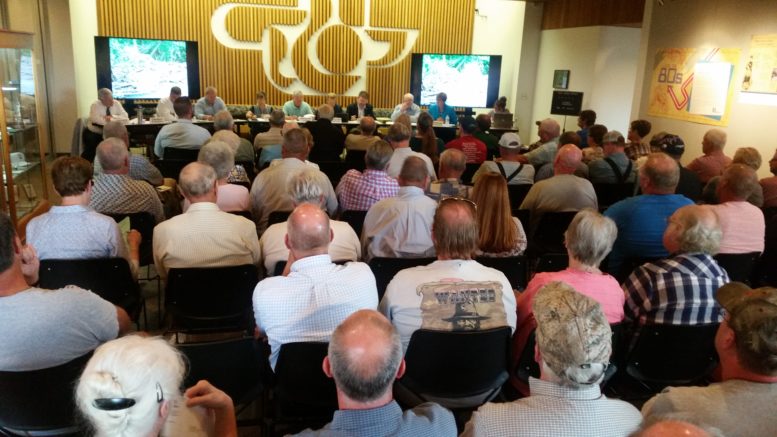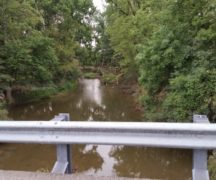By JAN LARSON McLAUGHLIN
BG Independent News
Ten years after the petition was filed, the Portage River project will finally be moving forward. But not everyone along the river is happy about how it will affect their land and their wallets.
More than 80 people crowded outside the Wood County Commissioners Office on Tuesday for the final hearing on the river cleanup. Some had waited a decade for the project to be approved. Others, however, were unhappy about paying for the project, didn’t want county workers on their land, and worried that the cleanup upstream will cause more flooding downstream.
But as the hearing came to a close, the county commissioners from all three counties involved voted in favor of the river cleanup.
The project is the biggest river project undertaken in Wood County in terms of area, according to Wood County Engineer John Musteric. It follows 46 miles of the south and east branches of the Portage River, covering 111 square miles of watershed in Wood, Hancock and Seneca counties, affecting about 8,200 parcels of land.
While the size of the project is great, the scope is not. There will be no digging, no widening, no channelizing. The river branches will be allowed to keep their meandering paths. The work will only remove logjams and trees leaning into the river.
The cleanup of the Portage River branches is intended to reduce future flooding.
The estimated cost of the project – $658,914 – will be divided among the landowners, based on the benefits their properties are expected to experience.
When county engineer staff walked the river routes after the petition was filed a decade ago, there were approximately 243 log jams, 4,300 dead, fallen or leaning trees. It is believed there are now many more downed trees due to ash borer beetles.
As the hearing was held Tuesday, photos of blocked waterways were shown on large screens in the front of the room.
“The pictures speak very loudly,” said Gary Harrison, a farmer and one of the original petitioners with Jack Stearns. When the logjams are removed, the creeks will stop rerouting themselves and stop “chewing out the banks,” he said.
“We tend to do maintenance on our automobiles, we tend to do maintenance on ourselves,” Harrison said. But the trees along the river branches have been allowed to die and create blockages. “A lot of them are ending in the creek.”
“These logjams are huge. They need to be removed,” Harrison said, stressing that the cleanup with reduce flooding. “The water’s not going to stay and have a party, it’s going to get to where it needs to get.”

Portage River at Holcomb Road
Another farmer spoke out in favor of the project. “It don’t take a rocket scientist to look at those pictures and see that something needs to be done. We need drainage that works. Everybody needs to pay and it needs done.”
But others who own land along the river branches were not pleased with the project or their payments.
Robert Hunker said he and his son have already cleaned trees out of their portion of the river. “So I’m not ready to pay for the other guy who didn’t,” he said.
Hunker also objected to the project giving the county engineer’s office a 100-foot temporary easement, and a 25-foot permanent easement along the river – while he is paying taxes on the property.
Randy Kinney said he lives in a floodplain along the project, and feels as if no one cares about people whose homes flood frequently. “I have water that comes right up to my house,” he said.
Bob Kreienkamp, who owns farmland near New Rochester, said his property already floods. It’s bound to only get worse once the cleanout is completed, since the work stops at New Rochester.
“When I pour more water in a funnel than it can hold, it backs up really fast,” he said.
Flooding this year has already drowned out some of his acreage, so he is expecting just two bushels an acre of soybeans.
“If we get 3 inches of rain, the south end of the watershed will be nice and drained,” Kreienkamp said. “How far and how fast is that going to back up in New Rochester?”
Duane Abke, with the county engineer’s office, said New Rochester shouldn’t have to worry since there are no logjams between that community and Pemberville. However, Pemberville may experience more flooding due to its bridges and to some floodplain areas being filled in the past.
Pemberville Mayor Gordon Bowman shared those concerns.
“I believe the cleanout will help areas,” – but not his community, he said. “If water comes faster in Pemberville, it will cause more flooding.”
Some asked why the cleanout stops in New Rochester, rather than continuing out to Lake Erie. However, the petition only covered the portions up to New Rochester.
“We keep hearing talk, we keep getting flooded,” said Gene Steele, of Pemberville. “Government is unresponsive to the needs of the people.”
Others at the hearing were concerned about their acreage and how it will be left after the fallen trees have been removed. Jim Deiter was not comforted by the fact that the trees will be left on the banks, far enough back so they don’t float back into the waterways.
“It’s going to be up to the property owners to take care of the debris,” Musteric said. “You can burn them, as property owners. The Wood County Engineer’s Office can’t burn anything.”
That didn’t sit well with one woman in the crowd. “We’re paying to take it out, then we’re working to get rid of it.”
But Abke said most of the dead wood will rot away if left in wooded areas along the river branches.
Once the river project is completed, it will be put under a county maintenance plan.
The assessments to each landowner will be based on the projected benefit of the project to their property. The assessments can be paid all at once or be spread out over seven years on their taxes. If the project bid comes in under estimates, the assessments will be adjusted.
Any individual objecting to the cleanup will have 21 days to file an appeal, Musteric said.
The cleanout is expected to begin this winter and be completed by Aug. 1, 2019.



